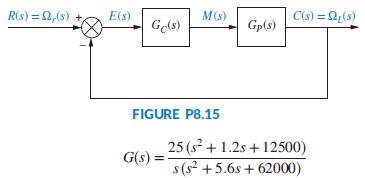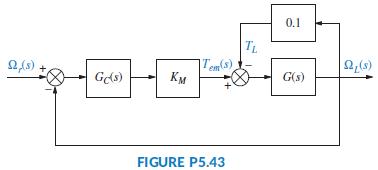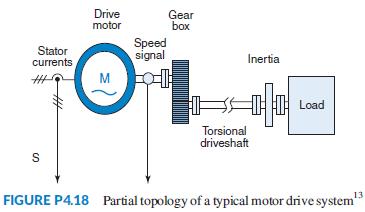Question: Design a PID controller for the drive system of Problem 56, Chapter 8, and shown in Figure P8.15 (Thomsen, 2011). Obtain an output response, L(t),
Design a PID controller for the drive system of Problem 56, Chapter 8, and shown in Figure P8.15 (Thomsen, 2011). Obtain an output response, ωL(t), with an overshoot 15%, a settling time of preferably 0.2 second, but not more than 5 seconds, a zero steady-state position error, and a velocity error of
Data From Problem 56, Chapter 8:
Figure P8.15 shows a simplified drawing of a feedback system that includes the drive system

presented in Problem 67, Chapter 5 (Thomsen, 2011). Referring to Figures P5.43 and P8.15, Gp(s) in Figure P8.15 is given by:

Given that the controller is proportional, that is, GC(s)= KP, use MATLAB and a procedure similar to that developed in Problem 40 in this chapter to plot the root locus4 and obtain the output response, c(t) = ωL(t), when a step input, r(t)= ωr (t) = 260 u(t) rad/ sec, is applied at t = 0. Mark on the time response graph, c(t), all relevant characteristics, such as the percent overshoot (which should not exceed 16%), peak time, rise time, settling time, and final steady-state value.
Data From Problem 67, Chapter 5:
A drive system with an elastically coupled load was presented in Problem 71, Chapter 4. The mechanical part of this drive (Thomsen, 2011) was reduced to a two-inertia model. Using slightly different parameters, the following transfer function results:

Here, T(s) = Tem(s) - TL(s), where Tem (s) = the electromagnetic torque developed by the motor, TL(s) = the load torque, and ΩL(s) = the load speed.
The drive is shown in Figure P5.43 as the controlled unit in a feedback control loop, where Ωr(s) = the desired (reference) speed. The controller transfer function is GC(s) = Kp + KI/s = 4 + 0.5/s and provides an output voltage = 0 – 5.0 volts. The motor and its power amplifier have a gain, KM = 10 N-m/volt.
a. Find the minor-loop transfer function, D(s) = ΩL(s)/Tem(s) analytically or using MATLAB.
b. Given that at t = 0, the load speed ωL(t) = 0 rad/sec and a step reference input ωr(t) = 260 u(t), rad/sec, is applied, use MATLAB (or any other program) to find and plot ωL(t). Mark on the graph all of the important characteristics, such as percent overshoot, peak time, rise time, settling time, and final steady-state value.

Data From Problem 71, Chapter 4:
A drive system with elastically coupled load (Figure P4.18) has a motor that is connected to the load via a gearbox and a long shaft.
The system parameters are: JM = drive-side inertia= 0.0338 kg-m2, JL = load-side inertia = 0.1287 kg-m2, K = CT = torsional spring constant = 1700 N-m/rad, and D = damping coefficient = 0.15 N-m-s/rad.
This system can be reduced to a simple two inertia model that may be represented by the following transfer function, relating motor shaft speed output, Ω(s), to electromagnetic torque input (Thomsen, 2011):

Assume the system is at standstill at t = 0, when the electromagnetic torque, Tem, developed by the motor changes from zero to 50 N-m. Find and plot on one graph, using MATLAB or any other program, the motor shaft speed, ω(t), rad/sec, for the following two cases:
a. No load torque is applied and, thus, ω = ωnl.
b. A load torque, TL = 0.2ω(t) N-m is applied and ω = ωL.

R(s) = 2,(s) E(s) M(s) C(s) = 2,(s) Gels) Gp(s) FIGURE P8.15 25 (s + 1.2s + 12500) s(s? +5.6s + 62000) G(s)
Step by Step Solution
3.49 Rating (179 Votes )
There are 3 Steps involved in it

Get step-by-step solutions from verified subject matter experts


